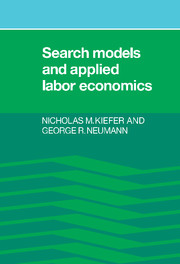Book contents
- Frontmatter
- Contents
- Preface
- 1 Introduction
- Part I Wages, reservation wages, and duration
- Part II Continuous-time models of duration
- Part III Applications
- 8 Structural and reduced form approaches to analyzing unemployment durations
- 9 Wages and the structure of unemployment rates
- 10 How long is a spell of unemployment? Illusions and biases in the use of CPS data
- Part IV Mobility and contracting
- Index
10 - How long is a spell of unemployment? Illusions and biases in the use of CPS data
Published online by Cambridge University Press: 06 October 2009
- Frontmatter
- Contents
- Preface
- 1 Introduction
- Part I Wages, reservation wages, and duration
- Part II Continuous-time models of duration
- Part III Applications
- 8 Structural and reduced form approaches to analyzing unemployment durations
- 9 Wages and the structure of unemployment rates
- 10 How long is a spell of unemployment? Illusions and biases in the use of CPS data
- Part IV Mobility and contracting
- Index
Summary
Introduction
Despite decades of intense interest in the sources and nature of unemployment, the answer to the simple question, How long do spells of unemployment last? has remained elusive. This is surprising, since economists are often tempted to interpret short spells of unemployment as a frictional (or normal) component of unemployment about which policy-makers need not be concerned and long-term (or chronic) unemployment as a disequilibrium component embodying most of its socially wasteful aspects. Hall (1972) and Marston (1976) pointed out that this is not a particularly useful distinction, since the high unemployment rates of many disadvantaged groups seem to be related to employment instability or frequent unemployment spells rather than lengthy individual spells. Nevertheless, the observation that the average spell of unemployment is relatively short has been used to support the position that most unemployment is essentially “voluntary.” Conversely, the inability of some individuals to locate a job over a period of several months is considered to be evidence of labor market malfunctioning. As a prelude to analyzing changes in the ratio of long-term to short-term unemployment. Green et al. (1978) stated in the Monthly Labor Review, “The length of time that workers remain unemployed is an important indication of the severity of the Nation's unemployment problem” (p. 12).
The duration data used to study unemployment comes almost exclusively from the Census Bureau's monthly Current Population Survey (CPS), the only representative sample obtained on a continuing basis.
- Type
- Chapter
- Information
- Search Models and Applied Labor Economics , pp. 203 - 226Publisher: Cambridge University PressPrint publication year: 1989



